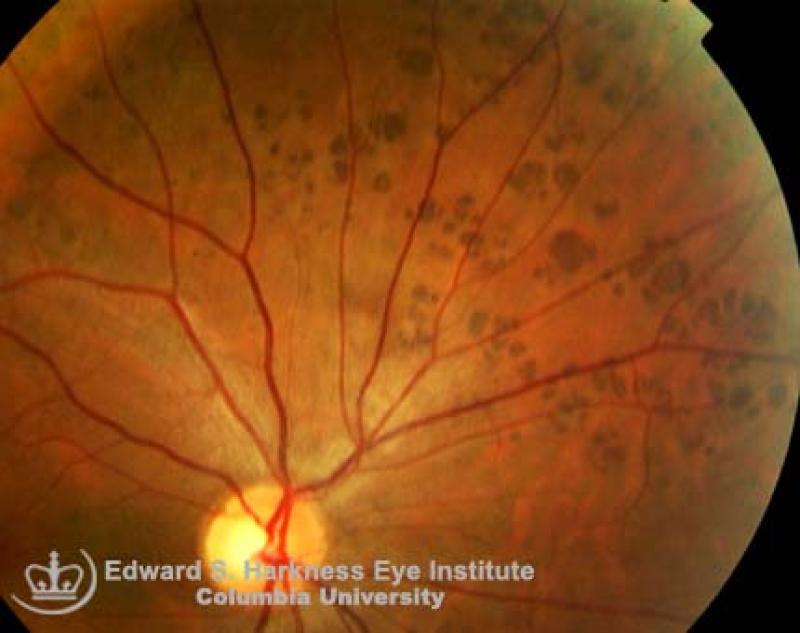

The differential for nyctalopia in children includes inherited retinal degenerations ( congenital stationary night blindness, retinitis pigmentosa, fundus albipunctatus, Oguchi disease, choroideremia), optic nerve pathology (glaucoma and other causes), vitamin A deficiency, autoimmune retinopathy, and cataracts. Nummular pigmentary deposits, the most common clinical exam finding in patients with ESCS, can be seen in other retinal dystrophies, including Bardet-Biedl syndrome, CRB1-associated early-onset severe retinal dystrophy, retinitis pigmentosa with preserved para-arteriolar RPE, and thioridazine retinopathy. Genetic testing for the NR2E3 gene can be sent to confirm the diagnosis and can be helpful in ambiguous cases. The yellow-white lesions are hyperautofluorescent.

įundus autofluorescence reveals decreased autofluorescence in the peripheral retina with relatively increased autofluorescence in the macula. Subretinal fibrosis due to choroidal neovascularization can be seen in some advanced cases. The torpedo-like lesions are associated with RPE atrophy and subretinal hyperreflective deposits. These schisis cavities can involute into areas of advanced atrophy. Optical coherence tomography (OCT) can demonstrate foveal schisis and the majority of patients with severe vision loss have advanced schisis. To elicit an S cone response, a blue wavelength is given on an orange background (suppressing red and green cones), resulting in an S cone response that is greater than normal and is the reason for the name of this disease.


The 30 Hz flicker response is of low amplitude and delayed. There are no systemic associations and patients can expect a normal life expectancy.ĭiagnosis is confirmed by pathognomonic findings on ERG and can be confirmed by genetic testing.ĮRG is critical for diagnosis and shows an absent rod response on low-intensity dark-adapted stimulus and a similar wave from to single white light flashes in both scotopic and photopic conditions. Other posterior pole findings include circumferential submacular fibrosis and torpedo-like atrophic lesions. Approximately 50% of patients will have subretinal yellow-white lesions in the posterior pole, and these can then progress to the more classic pigmented lesions. The characteristic findings on exam are nummular pigmentary changes along the vascular arcades (Figure 1), found in about 85% of patients. Color vision is typically diminished with the preservation of the tritan axis and incraesed sensitivity to blue light. Visual acuity can range from normal to profoundly impaired, with approximately 30% of patients having a visual acuity of 20/100 or worse. There is a broad range of disease severity. Other presenting symptoms include refractive accommodative esotropia, nystagmus, decreased visual acuity, hemeralopia, and incidental retinal lesions on examination. HistoryĮSCS typically presents in childhood with nyctalopia. DiagnosisĮlectroretinographic findings are critical in the diagnosis of ESCS showing no rod response both scotopic and photopic ERG wave forms are similar. In rare cases, mutations in the NRL gene, which acts upstream of the NR2E3 transcription factor, can lead to ESCS. During embryology, the malfunctioning NR2E3 transcription factor is hypothesized to result in a differentiation error resulting in too many S cones being produced and no rods. The S cone is one of three types of retinal cones and is the least common cone in the normal human retina. The mutation of the NR2E3 receptor results in a gain of function in S cones. EtiologyĮSCS is a progressive autosomal recessive retinal degeneration caused by a mutation in nuclear receptor subfamily 2, group E, member 3 (NR2E3) gene and rarely in the NRL gene. The characteristic electroretinogram (ERG) findings were first described in 1990 and are important in the diagnosis of this genetic disease. © 2020 American Academy of OphthalmologyĮnhanced S Cone syndrome (ESCS) is a relatively newly described and very rare inherited progressive retinal degeneration that can cause severe vision loss. This fundus image demonstrates the classic nummular pigmented retinal lesions seen in Enhanced S Cone Syndrome.


 0 kommentar(er)
0 kommentar(er)
